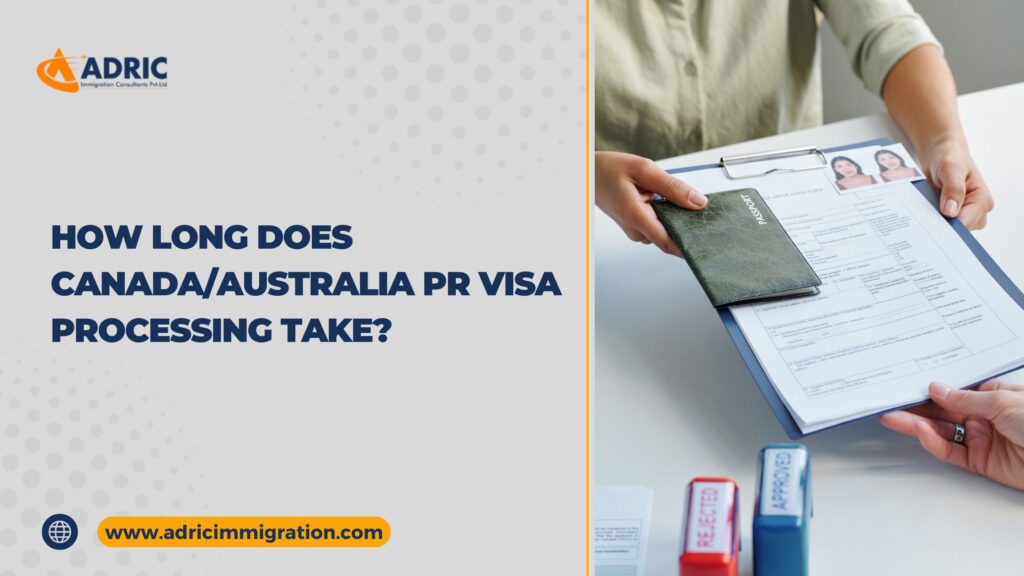If you’re considering moving to Canada or Australia, one of the most important questions you’ll have is: “How long does the Permanent Residency (PR) visa processing take?” Understanding the timeline can help you plan your move and set realistic expectations. In this blog, we’ll explore the general processing times for Canada and Australia PR visas, factors that influence these times, and tips to expedite your application.
Canada and Australia PR Visa Processing Time
Canada PR Visa Processing Time
Canada offers several pathways to Permanent Residency, each with its own processing time. The most common PR pathways include:
- Express Entry System: This is the fastest route for skilled workers. The Express Entry system manages three main immigration programs:
- Federal Skilled Worker Program (FSWP)
- Federal Skilled Trades Program (FSTP)
- Canadian Experience Class (CEC)
- The processing time for Express Entry is typically around 6 to 8 months from the date of submission of the complete application. However, this can vary based on the volume of applications and the completeness of your documents.
- Provincial Nominee Program (PNP): If you receive a nomination from a Canadian province, you can apply for PR through the PNP. The processing time for PNP applications is generally 15 to 19 months. This includes both the provincial nomination stage and the federal PR application stage.
- Family Sponsorship: If you are being sponsored by a family member, the processing time for family sponsorship applications is usually around 12 months. This time frame can vary depending on the specific circumstances of the case.
- Quebec-selected Skilled Workers: For those selected by Quebec, the processing time can be 15 to 24 months. This includes both the Quebec immigration process and the federal PR application process.
Australia PR Visa Processing Time
Australia also offers several pathways to Permanent Residency. Here’s a breakdown of the processing times for the most common PR visas:
- Skilled Migration Visas (Subclasses 189, 190, 491):
- Subclass 189 (Skilled Independent Visa): The processing time for this visa is typically between 8 to 12 months. This visa is for skilled workers who are not sponsored by a state or territory.
- Subclass 190 (Skilled Nominated Visa): The processing time for this visa ranges from 8 to 12 months as well. This visa requires a nomination from an Australian state or territory.
- Subclass 491 (Skilled Work Regional (Provisional) Visa): The processing time is generally around 8 to 12 months. This visa allows you to live and work in regional areas of Australia.
- Family Migration Visas:
- Subclass Partner Visas (Subclasses 820 and 801): Processing times for partner visas can range from 15 to 24 months. This depends on the complexity of the case and whether additional information is needed.
- Subclass Parent Visas (Subclass 143 and 173): The processing time for parent visas is usually around 30 to 50 months. This long wait is due to high demand and limited places available.
- Business and Investor Visas:
- Subclass 188 (Business Innovation and Investment Visa): Processing times are typically 12 to 18 months, depending on the stream you apply under and the complexity of your business or investment.
Factors Affecting PR Visa Processing Times
Several factors can influence the processing times for PR visas in both Canada and Australia:
- Completeness of Application: Submitting a complete and accurate application can significantly impact processing times. Incomplete applications or missing documents can lead to delays.
- Volume of Applications: High volumes of applications can lead to longer processing times. Both Canada and Australia periodically experience peak periods which can affect the speed of processing.
- Background Checks: The time taken for security and health checks can vary. If there are issues or additional scrutiny required, it can delay the processing of your application.
- Changes in Immigration Policy: Changes in immigration laws or policies can also affect processing times. Keeping updated with any policy changes is crucial.
- Additional Information Requests: If immigration authorities request additional information or documentation, it can extend the processing time.
Tips to Expedite Your PR Visa Application
- Ensure Accuracy and Completeness: Double-check all forms and documents before submission. Incomplete or incorrect information can lead to delays.
- Prepare in Advance: Gather all necessary documents ahead of time. Having everything ready can help avoid delays.
- Stay Informed: Keep track of your application status and respond promptly to any requests for additional information.
- Consult an Immigration Consultant: Working with a qualified immigration consultant, like Adric Immigration, can help streamline your application process and provide expert advice.
- Be Patient: PR visa processing times can be lengthy. While it’s important to plan and prepare, it’s equally important to be patient and allow the process to take its course.
Conclusion
Understanding the processing times for PR visas in Canada and Australia is crucial for effective planning. While the timelines can vary based on the type of visa, completeness of your application, and other factors, staying informed and prepared can help make the process smoother. Whether you’re looking to settle in Canada or Australia, being aware of these timelines and taking the right steps can lead to a successful PR application. If you need assistance with your PR visa application, consulting with a trusted immigration advisor like Adric Immigration can provide valuable support and guidance throughout the process.
Feel free to reach out for more information and support in your journey towards obtaining Permanent Residency in Canada or Australia.

